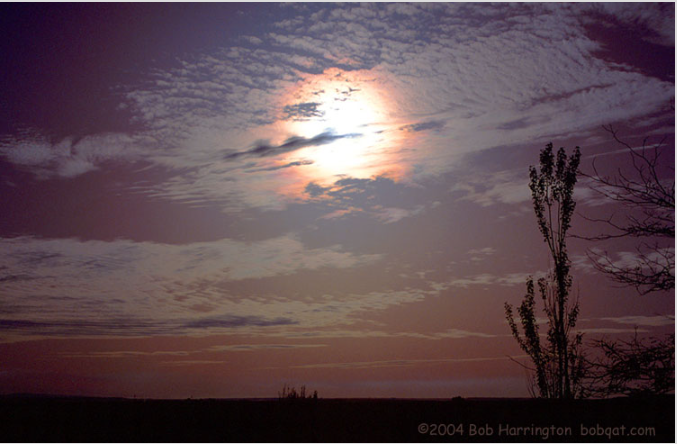Bishop's ring and corona
Bishop's Ring and Corona: A Phenomenon of Atmospheric Optics
Atmospheric optics is a fascinating field that encompasses a variety of optical phenomena that occur in the Earth's atmosphere. One such phenomenon is the Bishop's ring and corona, which can create breathtaking displays in the sky. In this article, we will delve into the intricacies of this phenomenon, exploring its formation, characteristics, and the factors that contribute to its appearance.
Understanding the Bishop's Ring and Corona
The Bishop's ring and corona are optical phenomena that occur when sunlight interacts with tiny particles or droplets in the atmosphere. These particles can range from dust and ash to water droplets or ice crystals. When sunlight passes through these particles, it undergoes scattering and diffraction, resulting in the formation of a ring or corona around the Sun or Moon.
The Formation of the Bishop's Ring
The Bishop's ring is a ring of light that surrounds the Sun or Moon, appearing as a faint halo with a reddish or bluish hue. This ring is caused by diffraction, which occurs when light waves bend around obstacles or pass through small openings. In the case of the Bishop's ring, the particles in the atmosphere act as obstacles, causing the diffracted light to form a ring around the celestial body.
Factors Affecting the Appearance of the Bishop's Ring
Several factors influence the appearance of the Bishop's ring. These include:
-
Particle Size: The size of the particles in the atmosphere plays a crucial role in determining the size and intensity of the Bishop's ring. Smaller particles tend to produce more pronounced rings, while larger particles may result in a less defined ring.
-
Particle Composition: The composition of the particles also affects the color of the Bishop's ring. Different types of particles can scatter light at different wavelengths, leading to variations in color. For example, ash particles from volcanic eruptions can produce a bluish ring, while water droplets can create a reddish ring.
-
Atmospheric Conditions: The overall atmospheric conditions, such as humidity and temperature, can influence the formation and visibility of the Bishop's ring. Moisture in the air, for instance, can enhance the scattering of light, resulting in a more vibrant and noticeable ring.
The Corona: A Companion to the Bishop's Ring
Accompanying the Bishop's ring is another optical phenomenon known as the corona. The corona appears as a series of concentric colored rings around the Sun or Moon, with the innermost ring being the most vivid. Unlike the Bishop's ring, which is caused by diffraction, the corona is formed through the process of scattering.
Scattering and the Formation of the Corona
Scattering occurs when light interacts with particles or droplets that are comparable in size to the wavelength of light. The corona is created when sunlight passes through these particles and scatters in various directions. The scattered light then interferes constructively or destructively, resulting in the formation of concentric rings of different colors.
Factors Influencing the Appearance of the Corona
Several factors contribute to the appearance of the corona:
-
Particle Size: Similar to the Bishop's ring, the size of the particles plays a role in determining the size and intensity of the corona. Smaller particles tend to produce more distinct and colorful rings.
-
Particle Distribution: The distribution of particles in the atmosphere affects the shape and symmetry of the corona. Uniformly distributed particles result in well-defined rings, while uneven distributions may cause irregularities in the corona's appearance.
-
Light Wavelength: The wavelength of light also influences the colors observed in the corona. Shorter wavelengths, such as blue and violet, tend to scatter more strongly, leading to their dominance in the inner rings of the corona.
Capturing the Beauty of Bishop's Rings and Coronas
Witnessing a Bishop's ring and corona can be a captivating experience, and capturing their beauty through photography can further immortalize these fleeting moments. Photographers often use specialized filters and techniques to enhance the visibility and colors of these atmospheric phenomena. Long exposures and careful positioning of the Sun or Moon in the frame can also yield stunning results.
Conclusion
The Bishop's ring and corona are awe-inspiring optical phenomena that grace our skies under specific atmospheric conditions. Understanding the science behind their formation allows us to appreciate the intricate interplay of light and particles in our atmosphere. So, next time you gaze up at the Sun or Moon, keep an eye out for these enchanting rings and coronas that remind us of the wonders that exist above us.

Two coronas. The smaller bright red rimmed aureole is made by water droplets in the visible tropospheric cloud. The outer glow pervading almost the whole of the image is a Bishop's ring produced by ash and hydrated sulfate particles injected into the stratosphere by the eruption of Mount Pinatubo. Bob Harrington (site) took this late one afternoon in the early 90s in the Pacific Northwestern USA. Another Bishop's Ring. Pinatubo sunset over Puget Sound. Image ©2004 Bob Harrington, reproduced with permission.
Note: this article has been automatically converted from the old site and may not appear as intended. You can find the original article here.
Reference Atmospheric Optics
If you use any of the definitions, information, or data presented on Atmospheric Optics, please copy the link or reference below to properly credit us as the reference source. Thank you!
-
<a href="https://atoptics.co.uk/blog/bishops-ring-and-corona/">Bishop's ring and corona</a>
-
"Bishop's ring and corona". Atmospheric Optics. Accessed on December 26, 2024. https://atoptics.co.uk/blog/bishops-ring-and-corona/.
-
"Bishop's ring and corona". Atmospheric Optics, https://atoptics.co.uk/blog/bishops-ring-and-corona/. Accessed 26 December, 2024
-
Bishop's ring and corona. Atmospheric Optics. Retrieved from https://atoptics.co.uk/blog/bishops-ring-and-corona/.